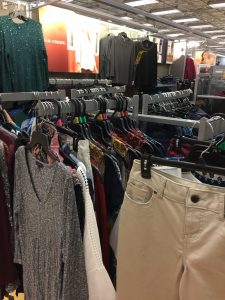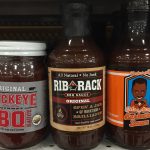By Chris Watson
“Of course I try to buy local…”
We all say it. We all mean it. Some of us even think about it a lot (such as writers for local web sites and newspapers). For many of us, however, we struggle to have our actions match our rhetoric. It isn’t because we are fibbing. It is because buying local can be, not to put too fine a point on it, hard.
Needs, Wants, and the Weight of History
First let us dispense with the usual issue that buying local food, especially produce off season, is possible or practical. We live in an interconnected food nation and one of the blessings of our Western culture is that we can enjoy a Florida orange in Ohio or eat strawberries on our pancakes in December. Plus we can get caught

up in the statistic that a carrot travels 1800 miles to get to our plate. That study, conducted by Iowa State University’s Leopold Center for Sustainable Agriculture, was a limited look at “food miles” and although shocking at first, only studied food flowing to Chicago and only estimated mileage from a state of origin (the study simply counted a generic orange traveling an average distance from “Florida”, not a specific part of Florida, which is a big state). Nor did the study include meat, breads or dairy, which tend to be produced locally. Yes, food travels to get to us. This allows us to eat delicious stone ground grits from South Carolina, while loading them up with cheese from Wisconsin and shrimp from the Gulf Coast.
Second, many products we enjoy are not now and will not be made locally any time soon. Clothing is an obvious villain but there are others.

Many of our day to day products, from toilet paper to shower gel are shipped
from places distant. Again, one of the blessings of western culture is that we don’t have to do without soap because it can’t be made in our backyard efficiently.
Finally, it is unrealistic to think that buying globally is a recent phenomenon. Silk, spices, woods, animal furs and metals have been traded between tribes, empires, and societies since…well since we stopped using rocks as weapons. Wars have been fought over vital trade routes for millennia and some of those war participants considered the bow and arrow “modern”.
Desperately Seeking Local
For all the above reasons, we often think that buying local is, if not impossible, problematic. What is misunderstood is that there is a fundamental difference between things that are produced locally and things that are sold locally. We should always look to support things that are produced or serviced locally. Everyone knows that a local diner is better than a fast food joint. No one would deny that a local, much loved salad dressing is better than something manufactured three states away by a giant food producer. And we have excellent farmers’ markets and growers that, when seasonably possible, produce amazing produce and sell it farm to table.
Let’s return to our 1800-mile carrot. Even if we acknowledge that much of our food is produced outside of the local orbit it doesn’t mean that we can’t buy that well-traveled carrot from a local market. We have several great, small markets in our area that not only carry a good selection of regionally produced food and produce, but they are owned and operated locally. The rule holds true across the spectrum of products and services. Any product that is produced outside of our local economy can be purchased from a smaller local merchant instead of spending the same dollars at a big box store or on the internet. And those dollars count…a lot.
A recent Huffington Post article featured a stunning infographic depicting just how strongly shopping at a locally owned business effects the local economy. According to the Andersonville Study of Retail Economics*, a local business generates 70 percent more local economic activity per square foot of retail space than a big box retailer. That alone is worth seeking local. The numbers don’t lie. For every $100 spent at a local retail establishment, on average $68 are retained in local economic activity, as opposed to $48 at a big box store (some studies argue the big box number is closer to $43).
Putting it another way, for every dollar spent at a local retailer instead of online or at a big box store, twenty cents per dollar MORE is retained locally. If every household (not person but household) within our city limits shifted just $10 a month to local purchases, this would result in an additional $3 million retained in the local economy. If we broaden the figures to our region the economic impact climbs to well over $8 million. And that is just $10 per month.
Half A Loaf Is Better
Given the economics of retail, no one should be expected to spend 100% of their shopping dollars at local stores. The time, finances, cost, and energy necessary is an unrealistic burden. All of us, even the most ardent local supporter, drop by a megamart for a gallon of milk or bottle of shampoo. The unfortunate truth is that when we have buying choices…like at the holidays or when time and money permit, we become stymied by the half loaf – full loaf dilemma. Many of us feel that if we don’t fully support the buy local movement our partial support isn’t worth it.

Although cliché, half a loaf is better than no loaf. Most local retailers and service providers would never expect all your dollars. These local businesses recognize that in a world of two day (and in some locations, same day) internet delivery, massive purchasing agreements, and global product production, shopping local is a commitment and even a lifestyle change. You will find no greater understanding of a household’s economic restrictions and the stress that accompanies those restrictions than at your local business.
This shopping and buying season make the shift. Look for opportunities to buy the same gift, service, or product from a local supplier. Your small effort has enormous impact on our local economy. The ripples across the economic spectrum, from tax retention, job creation, even local charitable support, have great influence no matter how much you spend. Make your dollars count. Support our local merchants
*Additional studies and information can be found at the Institute for Local Self Reliance, including impact studies of big box retailing vs local owned and controlled merchants and product distribution.










